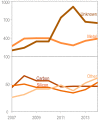Nanotechnology in the real world: Redeveloping the nanomaterial consumer products inventory
- PMID: 26425429
- PMCID: PMC4578396
- DOI: 10.3762/bjnano.6.181
Nanotechnology in the real world: Redeveloping the nanomaterial consumer products inventory
Abstract
To document the marketing and distribution of nano-enabled products into the commercial marketplace, the Woodrow Wilson International Center for Scholars and the Project on Emerging Nanotechnologies created the Nanotechnology Consumer Products Inventory (CPI) in 2005. The objective of this present work is to redevelop the CPI by leading a research effort to increase the usefulness and reliability of this inventory. We created eight new descriptors for consumer products, including information pertaining to the nanomaterials contained in each product. The project was motivated by the recognition that a diverse group of stakeholders from academia, industry, and state/federal government had become highly dependent on the inventory as an important resource and bellweather of the pervasiveness of nanotechnology in society. We interviewed 68 nanotechnology experts to assess key information needs. Their answers guided inventory modifications by providing a clear conceptual framework best suited for user expectations. The revised inventory was released in October 2013. It currently lists 1814 consumer products from 622 companies in 32 countries. The Health and Fitness category contains the most products (762, or 42% of the total). Silver is the most frequently used nanomaterial (435 products, or 24%); however, 49% of the products (889) included in the CPI do not provide the composition of the nanomaterial used in them. About 29% of the CPI (528 products) contain nanomaterials suspended in a variety of liquid media and dermal contact is the most likely exposure scenario from their use. The majority (1288 products, or 71%) of the products do not present enough supporting information to corroborate the claim that nanomaterials are used. The modified CPI has enabled crowdsourcing capabilities, which allow users to suggest edits to any entry and permits researchers to upload new findings ranging from human and environmental exposure data to complete life cycle assessments. There are inherent limitations to this type of database, but these modifications to the inventory addressed the majority of criticisms raised in published literature and in surveys of nanotechnology stakeholders and experts. The development of standardized methods and metrics for nanomaterial characterization and labelling in consumer products can lead to greater understanding between the key stakeholders in nanotechnology, especially consumers, researchers, regulators, and industry.
Keywords: consumer products; database; inventory; nanoinformatics; nanomaterials.
Figures









References
-
- The Project on Emerging Nanotechnologies [Mar 25;2015 ];Consumer Products Inventory. Available from: http://www.nanotechproject.org/cpi.
-
- Michelson E S. Rev Policy Res. 2013;30:464–487. doi: 10.1111/ropr.12034. - DOI
-
- Maynard A D. Nanotechnology: A Strategy for Addressing Risk. Woodrow Wilson International Center for Scholars; 2006. p. 45.
LinkOut - more resources
Full Text Sources
Other Literature Sources
